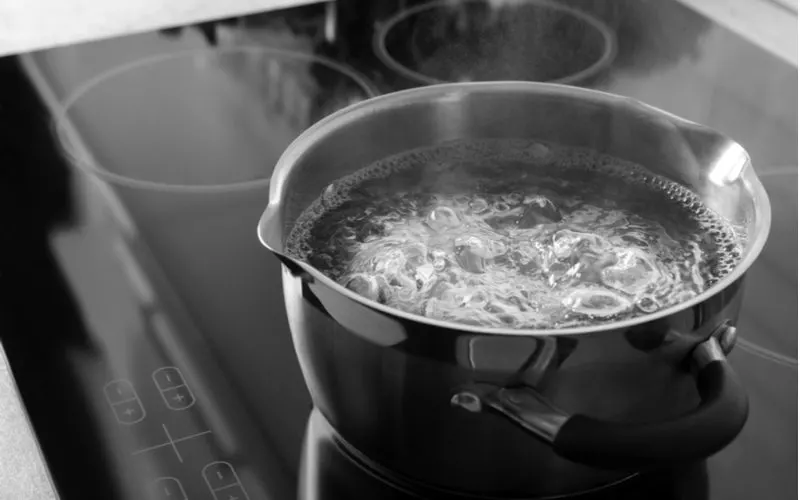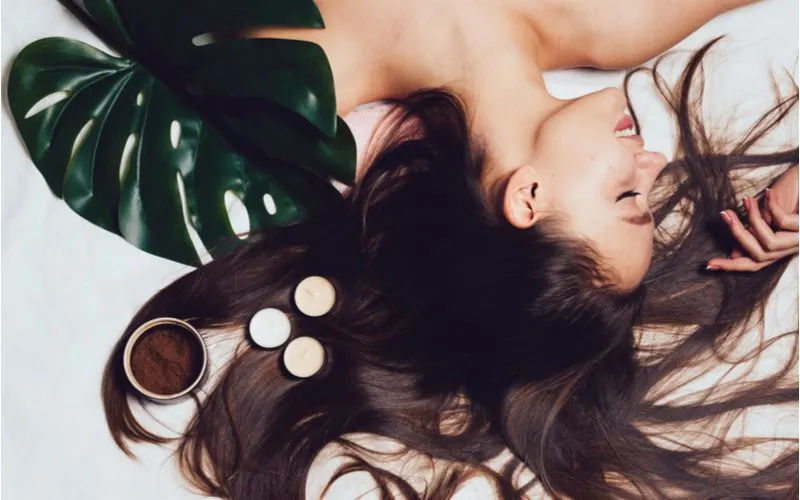Jump to:
On every corner of the internet, from respectable websites to slapdash YouTube vlogs, you’ll find so-called style authorities echoing the unfounded claim that boiling hard water rids it of minerals that can otherwise leave hair feeling dry, brittle, and lifeless.
The reality is, this science-experiment-slash-haircare-hack only works under a very specific (and not altogether common) set of conditions. In all other cases, it boils down to a waste of valuable time and utilities.
How to Boil the Bad Stuff Out of Your Water

New Africa/Shutterstock
Let’s make one thing clear from the get-go: boiling hard water doesn’t soften it. In fact, it can actually make it even harder by evaporating out some of the pure water, thereby increasing the overall concentration of sulfates, chlorides, heavy metals, and other undesirable elements.
Most hair influencers fail to mention this inconvenient fact, which is no surprise, as it all but busts the myth they’re trying to proliferate. Like so many other things, however, there are exceptions to this rule.
It has been shown that boiling can reduce “temporary hardness,” or hardness caused by high levels of dissolved bicarbonates like calcium and magnesium.
So, if you know for a fact that one or both of the aforementioned minerals is behind your hard water problem, bringing the affected H20 up to 212℉ (100℃) for a few minutes may just be your ticket out of Straw Hair City.
Boiling your wash water is also useful when done as part of a compound cleansing strategy, such as making your own all-natural clarifying rinses or shampoo alternatives. More on that to follow.
Boiling Hard Water to Wash Hair: A Summary
- Bring a Pot of Water to a Boil
- Allow the Water to Cool to a Safe Temperature
- Squeeze in Some Shampoo or Another Cleanser
- Wash Your Hair With the Shampoo Solution
- Rinse Thoroughly
- Bonus: Cap Things off With an Apple Cider Vinegar Rinse
It bears repeating that this is neither the most efficient nor effective way to soften hard water for hair care purposes. Resources permitting, you’d be much better off replacing your normal showerhead with one containing a special water softening filter.
Better yet, consider going all-in on a water softening system for your whole home. It’s a big purchase, but it could end up paying for itself rather quickly if you’re in the habit of washing your hair multiple times per week.
How to Boil Hard Water to Wash Your Hair
Now that we’ve got the technicalities out of the way, here’s a step-by-step guide for using heat to shock hard water into submission.
1. Bring a Pot of Water to a Boil
Fill a large pot with hard water from the tap, put it on the stove, and crank up the heat. Then, find something productive to do for the next little bit (you know what they say about watched pots).
How much water you use is totally up to you.
Those with relatively low-maintenance coiffures might be able to make do with just a few cups, while others will likely require several liters to get the job done satisfactorily. Some factors that may determine how well you fare with a given quantity include:
- The length of your hair
- The thickness of your hair
- Your hair’s texture
- The type and amount of any additional cleansing agents you plan on using
Once you’ve figured out how much water you need, double your measurement to ensure that you have enough left over to rinse with. For best results, experts suggest boiling water for a minimum of five minutes.
Doing so will give unwanted mineral salts plenty of time to dissolve and precipitate or resolidify outside of the water (in this case, on the inner surface of the pot).
2. Allow the Water to Cool to a Safe Temperature
No good can come from dunking your head in a pot of freshly boiled water. We know you’re excited to finally feel like your hair is really, truly clean.
But for safety’s sake, hold off on taking your next steps for 10-20 minutes or until the water has cooled down to the point where you can touch it without scalding yourself. If you’re in a rush, we recommend doing your boiling in advance.
That way, you can take care of other things while you’re waiting for the water to cool rather than sitting around twiddling your thumbs.
This can also be a great opportunity to prepare other pre-wash and post-wash treatments, such as a hydrating hair mask, nourishing leave-in conditioner or oil, or apple cider vinegar rinse.
3. Squeeze in Some Shampoo or Another Cleanser
Now, grab your go-to shampoo and add it directly into your wash water. Once again, the amount you use will depend on how much hair you have, how much water you’re washing it with, and how clean you’re attempting to get it.
Remember, shampoo (even the ultra-pricey, supposedly nourishing kind) can have some not-so-nice side effects if you overdo it, so err on the side of caution and be conservative if you’re uncertain about your proportions.
Stir the water by hand until the shampoo is evenly distributed throughout and a thin layer of suds begins to form on the surface of the solution. You’re now officially ready to lather up.
If you’ve recently made the momentous decision to go “no-poo” (we commend you for your courage and commitment), you can also whip up a quick-and-easy shampoo alternative by mixing a little baking soda with lemon juice or tea tree oil.
Add roughly one tablespoon of your cleaner of choice for every cup of water in your pot. For tea tree oil and other essential oils, four or five drops ought to do the trick.
4. Wash Your Hair With the Shampoo Solution
You have a couple of options for how to proceed from here: you can either dip the top of your noggin straight into the container of solution or pour it over your hair slowly.
The former technique is arguably superior since it gives you a chance to scrub. If you’d prefer to take the latter approach, transfer the solution to a lighter, more manageable container and hop in the shower—things are going to get wet.
Regardless of the method you choose, do your best to make sure that the solution comes into contact with as much of your hair as possible. Pay particular attention to the scalp and roots, as this is where the majority of oil and mineral buildup tends to collect.
5. Rinse Thoroughly
When you’re finished washing, use your second batch of pre-boiled water to rinse your hair from root to tip. As with the previous step, you can either dip or pour—your call.
What’s important is that your hair is completely free of lingering traces of shampoo or cleanser when it’s all said and done.
Afterward, gently squeeze (don’t wring) the excess water out of your hair and allow it to air dry, or wrap it in a soft, absorbent microfiber towel or t-shirt to speed things along. You should be able to feel the difference when you remove your wrap and free your squeaky-clean tresses.
Bonus Step: Cap Things off With an Apple Cider Vinegar Rinse (Optional)
If you’re especially concerned about the chemical composition of the water in your home, a post-wash apple cider vinegar rinse can provide you with some much-needed peace of mind.
Simply combine two tablespoons of raw, unfiltered apple cider vinegar with 1-2 cups of boiled water, pour the solution over your scalp, let it sit for a minute or two, then do one last rinse with cold water.
The acetic acid in the vinegar will break down any pesky mineral salts that have made it through the boiling process intact. You don’t have to worry about it eating away at your hair, either.
On the contrary, apple cider vinegar seals hair cuticles to lock in moisture for stronger, softer, smoother hair. It can even reset your scalp to its natural pH, reducing itchiness, inflammation, dandruff, and other irritating symptoms.
Frequently Asked Questions

nelen/Shutterstock
Does boiling hard water make it soft?
In a word, no. Boiling can help dissipate calcium and magnesium bicarbonates but has little or no effect on substances like sulfates and heavy metals, which are the real culprits of most hard water-related hair damage.
At worst, it can even be counterproductive, elevating hardness levels by increasing the concentration of various minerals as the water turns to vapor.
What’s the best way to soften hard water for washing hair?
Get yourself a water softening shower head to filter out offenders like the ones listed above. Many companies also make removable filters for different types of showerheads.
These are great for when you don’t want to go to the trouble and expense of switching out your current head. If you want to banish hard water once and for all, look into getting a water softening system for your home.
How do I get rid of hard water buildup in my hair?
Start by using a chelating shampoo to strip away the worst of the buildup (chelating shampoos are specifically designed to remove stubborn buildup like the kind created by hard water).
After shampooing, perform a bonus rinse with a mild apple cider vinegar solution to be doubly sure that no residue remains, or simply apply a dab of hydrating oil to restore vital moisture.
Can hard water cause baldness?
Not directly, no. That said, the abrasive minerals in hard water can cause breakage, split ends, follicle strain, and other types of damage.
Over time, damage of this sort can pile on until the hair strands begin to deteriorate, resulting in thinning or sparse patches. Fortunately, such havoc is rarely permanent and will usually improve when you remedy your hard water situation.
How do you wash your hair with hard water?
Your best defenses against the ravages of hard water are a good clarifying shampoo, regular vinegar or citrus rinses, and an array of natural moisturizers.
These items and their constituent ingredients (many of which you probably have in your kitchen cabinets right now) can prevent icky buildup from drying out your hair and making it feel like the business end of a broom.
So, How Do You Boil Hard Water to Wash Hair?
Truth be told, it’s probably best not to even bother unless you have no other recourse. It’s better to invest in a dedicated water softening showerhead filter or complete home system. Either solution will put an end to the issue once and for all.
If, for some reason, boiling is your only available course of action, be sure to let your water remain at peak temperature for at least five minutes and cool for another 10-20 before adding any cleansers.
Don’t forget to rinse well when finished, and follow up with an apple cider vinegar rinse for good measure if you think it’s necessary. With any luck, you’ll find that the water—and, consequently, your hair—is softer than it was before.
